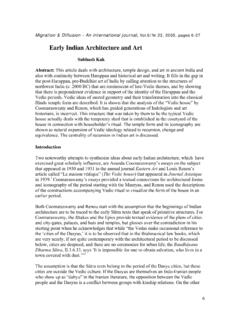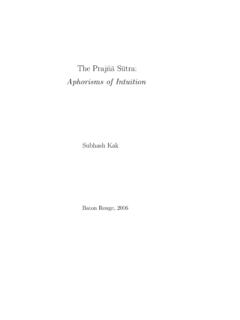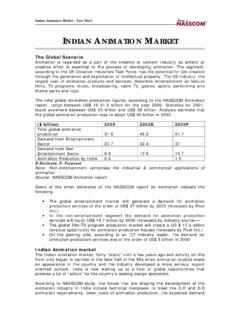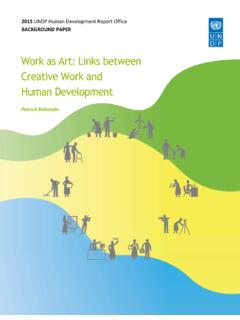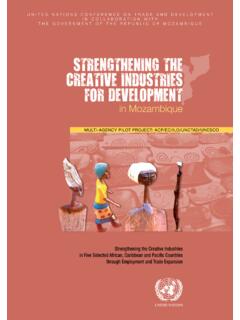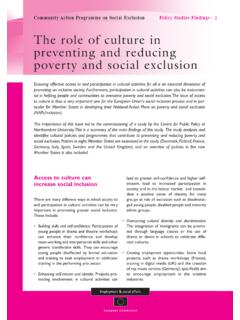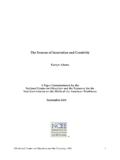Transcription of The Wonder That Was Kashmir - LSU
1 The Wonder that Was Kashmir Subhash Kak Kashmir s geographical location partly explains is cultural history. It may be that its natural beauty and temperate climate are the reasons that Kashmiris have a strong tradition in the arts , literature, painting, drama, and dance. Its relative isolation, the security provided by the ring of mountains around it, and its distance from the heartland of Indian culture in the plains of North india , might explain the originality of Kashmiri thought. Its climate and the long winters may explain the Kashmiri fascination for philosophical speculation.
2 Kashmir is at the centre of the Puranic geography. In the Puranic conception, the earth's continents are arranged in the form of a lotus flower. Mt. Meru stands at the center of the world, the pericarp or seed-vessel of the flower, as it were, surrounded by circular ranges of mountains. Around Mt. Meru, like the petals of the lotus, are arranged four island-continents (dvipas), aligned to the four points of the compass: Uttarakuru to the north, Ketumala to the west, Bhadrashva to the east, and Bharata or Jambudvipa to the south. The meeting point of the continents is the Meru mountain, which is the high Himalayan region around Kashmir , Uttarakuru represents Central Asia including Tocharia, Ketumala is Iran and lands beyond, Bhadrashva is China and the Far East.
3 Kashmir s centrality in this scheme was a recognition that it was a meeting ground for trade and ideas for the four main parts of the Old World. In fact it became more than a meeting ground, it was the land where an attempt was made to reconcile opposites by deeper analysis and bold conception. Kashmir s nearness to rich trade routes brought it considerable wealth and emboldened Kashmirs to take Sanskrit culture out of the country as missionaries. Kashmiris also became interpreters of the Indian civilization and they authored many fundamental synthesizing and expository works.
4 Some of these works are anonymous encyclopaedias, 1for many other works the author s name is known but the details of the life and circumstances in Kashmir are hardly remembered. Kalhana s Rajatarangini (River of Kings), written in about 1150, provides a narrative of successive dynasties that ruled Kashmir . Kalhana claimed to have used eleven earlier works as well the Nilamata Purana. Of these earlier books only the Nilamata Purana survives. The narrative in the Rajatarangini becomes more than mere names with the accession of the Karkota dynasty in the early seventh century.
5 The political boundaries of Kashmir have on occasion extended much beyond the valley and the adjoining regions. According to Hiuen Tsang, the Chinese traveler, the adjacent territories to the west and south down to the plains were also under the direct control of the king of Kashmir . With Durlabhavardhana of the Karkota dynasty, the power of Kashmir extended to parts of Punjab and Afghanistan. It appears that during this period of Kashmiri expansion the ruling elite, if not the general population, of Gilgit, Baltistan, and West Tibet spoke Kashmiri-related languages. Later, as Kashmir s political power declined, these groups were displaced by Tibetan speaking people.
6 In the eighth century, Lalitaditya (reigned 725-761), conquered most of north india , Central Asia and Tibet. His vision and exertions mark a new phase of Indian empire-building. Kashmir had become an important player in the rivalries amongst the various kingdoms of north india . The jostling of the Kashmiri State within the circle of the north Indian powers led to an important political innovation. The important Vishnudharmottara Purana, believed to have been written in Kashmir of the Karkota kings, recommends innovations regarding the rajasuya and the ashvamedha sacrifices, of which the latter in its medieval interpretations was responsible for much warfare amongst kings.
7 In the medieval times the horse was left free to roam for a year and the king s soldiers tried to establish the rule of their king in all regions visited by the horse, leading to fighting. The 2 Vishnudharmottara Purana replaced these ancient rites by the rajyabhisheka (royal consecration) and surapratishtha (the fixing of the divine abode) rites. This essay presents an overview of the most important Kashmiri contributions to Indian culture, emphasizing some of the lesser known aspects of these contributions. Specifically, we consider the contributions to the arts , sciences, literature, and philosophy.
8 Our historical assessment of Kashmiri culture is hampered by the nature of our records. The texts and objects of art do not always indicate their provenance and the connections with Kashmir emerge only from indirect evidence. We are on sure ground when we come to Buddhist sources, the texts of the Kashmir Shaivism, and the names mentioned in the Rajatarangini and other early narratives. Early Period During the Vedic period, Kashmir appears to be an important region because it appears that the Mujavant mountain, the region where Soma grew, was located there. It is possible that in the Vedic era a large part of the valley was still under a lake.
9 Kalhana s history begins with the Mahabharata War, but it is very hazy with regard to the events prior to the Mauryan Emperor Ashoka. The great grammarian Panini lived in northwest Punjab not too far from Kashmir and the university at Taxila (Takshashila) was also close to the valley. At the time of Hiuen Tsang, Takshashila was a tributary to Kashmir . It is generally accepted that Patanjali, the great author of the Mahabhashya commentary on Panini s Ashtadhyayi, was a Kashmiri, as were a host of other grammarians like Chandra. According to Bhartrihari and other early scholars, Patanjali also made contributions to Yoga (the yoga-sutras) and to Ayurveda.
10 It is believed that Patanjali's mother was named Gorika and he was born in Gonarda. He was educated in Takshashila and he taught in Pataliputra. From the textual references in his works, it can be safely said that he belonged to 2nd century BC. 3 The Charaka Samhita of Ayurveda that has come down to us is due to the editing of Dridhabala from Kashmir , who also added seventeen chapters to the sixth section and the whole of the eighth section. Patanjali may have been involved in this editing process. But it is likely that the identity of the Kashmiris as a distinct group had not solidified in the Vedic period and to speak of ethnicity at that time is meaningless.
